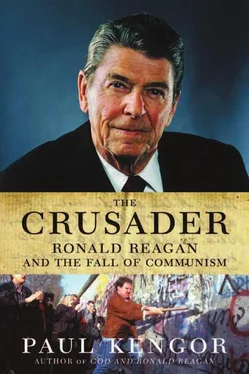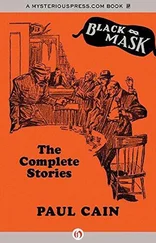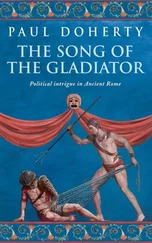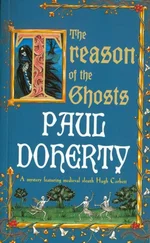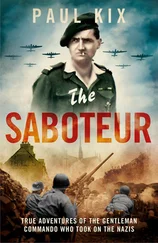A similar extraordinary example, also unnoted in Reagan biographies, took place only eight days later. This time, Reagan connected the earlier assassination of the other Kennedy, John F. Kennedy, to Soviet Communism. Speaking on June 13, 1968 at the Indiana State Fairgrounds in Indianapolis, Reagan promised his fellow midwesterners that “in the days ahead… you and I are going to write a page in history.” That remark was grand enough; yet, he said much more: a rare transcript shows that Reagan, on the heels of RFK’s shooting, was eager to remind Americans of the worldview that had motivated JFK’s murderer:
Five years ago, a president was murdered by one who renounced his American citizenship to embrace the godless philosophy of Communism, and it was Communist violence he brought to our land. The shattering sound of his shots were still ringing in our ears when a policy decision was made to play down his Communist attachment lest we provoke the Soviet Union. 21
Apparently, in the days since RFK’s assassination, Reagan had formulated a new angle in his outrage toward Soviet Communism: Moscow’s nefarious ways were leading, directly or indirectly, to the extermination of some of America’s leading political figures.
Although on the surface Reagan’s stark suspicions might have appeared to some as residual McCarthy-era hysteria, the reality was that both Jack and Bobby Kennedy were equally anti-Communist, a detail not wasted on Reagan. Both Jack and his father had crossed party lines and loyalties to support Republican Richard Nixon in his Senate bid against “Pink Lady” Democrat Helen Gahagan Douglas (for whom no less than an actor and liberal Democrat named Ronald Reagan had been campaigning). In what would later become a great irony in light of the 1960 presidential campaign, a check was mailed from the Kennedy home to Nixon’s campaign. Moreover, Bobby had once worked as a staff counsel to Senator Joe McCarthy, and even asked McCarthy to be the godfather of his first child, daughter Kathleen.
With controversial stances such as these on the Kennedy assassinations, Reagan was making himself one of the country’s most outspoken and polarizing voices on the Soviet Union. But as the 1960s came to a close, Reagan found himself still unable to impact U.S.–Soviet relations on a national scale. Although there was a Republican administration in the White House, it did not take long for Reagan to see that President Richard Nixon’s true stripes toward Communism did not add up to the hard line that Reagan felt was necessary.
While Ronald Reagan had already emerged as a future presidential candidate, the developments of the 1970s would embolden his efforts, giving him a greater imperative and sense of urgency. He had to continue along his political path—which for now was located in California, though it did not dead end in Sacramento. The governorship had been a crucial first step, but now it was time for him to take his statewide actions and achievements and put them on display for the entire nation to judge.
5. Breaking the Mold: 1970s
IN NOVEMBER 1978, PRESIDENTIAL CANDIDATE RONALD Reagan took a fact-finding trip to partitioned Germany. Accompanying the former governor were Richard V. Allen, Peter Hannaford, and the three men’s wives. The six Americans entered East Berlin through Checkpoint Charlie, from where they went to Alexanderplatz and entered a large store, unaware that the East German secret police were watching and photographing their every move. 1
As they left the store, they stood on the platz, observing the quiet shuffling of passersby, the lack of merriment, the drabness. At that moment, two East German policemen, Volskpolizisten, sauntered past and stopped a citizen carrying shopping bags. In front of the future president of the United States, a Cold Warrior already dedicated to undermining Communism, the police stupidly forced the shopper to drop his bags and show his papers, ignorant of the long-term repercussions of their actions. One of the officers rifled through the bags with the tip of an AK-47 while the other poked his victim with a machine gun. Reagan was enraged, his resolve steeled. Though just a routine shopping trip in the workers’ paradise, the incident, remembered Allen, “set Ronald Reagan’s blood to boiling….Reagan was livid, and muttered that this was an outrage.” 2
It was also a warm-up. Next the group ventured to the Berlin Wall, a structure that Reagan had remonstrated against since its construction. But now he felt its cruelty firsthand. There was something about being there, something sickeningly real about directly observing a wall in which the East German guards faced East, not West, patrolling their own people, not an outside enemy. Armed East German soldiers faced their own unarmed citizenry, many of whom they shot and killed; the “threat” came from those looking to escape, not enter. This, Reagan thought to himself in disgust, was Communism.
Reagan took it all in. The enormity of the inhumanity pressed upon him, heavy like that wall that separated East and West and sat erect like a gray, cold tombstone to human freedom. He stood in stunned silence for several minutes. The presidential hopeful then turned to Allen and company, telling them, “We have got to find a way to knock this thing down.” 3
Reagan’s forethought was part prophecy, part proclamation. Years later, Allen said correctly: “I believe the encounter with the wall and witnessing the armed harassment of an ordinary citizen seared into the governor’s memory the brutality of the communist system.” It “reinforced his dedication to placing it upon the ash heap of history.” “It was clear from his reaction,” said Allen, Reagan’s one-day national security adviser, “that he was determined to one day go about removing such a system.” 4
DURING THE 1970S, RONALD REAGAN BEGAN TO OUTLINE MORE specifically the areas of U.S. Cold War foreign policy with which he disagreed, a process which he undertook forcefully and bluntly. 5While he continued his ardent criticism of Soviet Communism during his governorship, his rhetoric remained strong even after he left Sacramento in early 1975. In what became a clear buildup to his two presidential campaigns of the decade, Reagan began to highlight the specific flaws of current and past United States’ models for dealing with the Soviet Union. Using the voice that he had been cultivating for nearly thirty years, Reagan in the 1970s became the nation’s most vocal champion for taking a tough stance on Russia. When many of America’s politicians, both Democrat and Republican, seemed ready to extend olive branches of détente to the Evil Empire, Reagan did not sit quiet.
In the 1970s, a consistent Reagan refrain was that the United States should not accept the existence of the Soviet empire and its subjugation of Eastern Europe. Specifically, there were three concepts related to the Cold War that Ronald Reagan adamantly and vocally refuted during this period: Yalta, containment, and détente.
Yalta took place in the Crimea (Soviet territory) in February 1945 and involved FDR, Churchill, and Stalin. The travesty that resulted from Yalta was that Stalin broke his promise to hold free and fair elections in Eastern Europe, with those nations instead becoming Communist satellites and part of the Soviet bloc. At Yalta, critics charge, FDR and Churchill naïvely sold out Eastern Europe, condemning the historic cities of Eastern Europe to a future of Soviet totalitarianism. These were the enslaved peoples behind the Iron Curtain; the inhabitants of the “captive nations.”
Ronald Reagan refused to accept that fate for Eastern Europe. “Reagan rejected Yalta, as if it were irrelevant,” said Ed Meese. “He felt it simply wasn’t right.” 6He never stopped complaining of Yalta. 7Indeed, Pravda later devoted space to informing Soviet citizens of Reagan’s explicit desire to undo Yalta. The Communist organ told readers that Reagan had declared that the dividing line between Western and Eastern Europe could never be legitimate. “We wish to undo this boundary,” it accurately quoted him as saying. 8
Читать дальше
